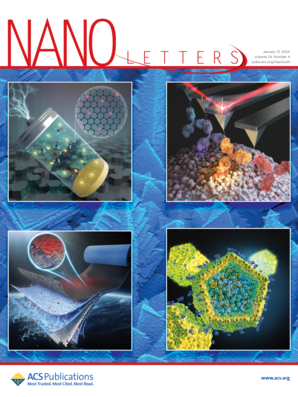Synergistic Enhancement Effects of Heterogeneous Isomorphism Clusters in Response to Irradiation: Sub-10 nm Nanolithography and Nanoscale Etching Transfer
IF 9.6
1区 材料科学
Q1 CHEMISTRY, MULTIDISCIPLINARY
引用次数: 0
Abstract
The advancement of integrated circuit manufacturing has continuously relied on lithography technology as a fundamental driving force. However, the development of photoresists faces a resolution-line edge roughness-sensitivity (RLS) trade-off, hindering simultaneous optimization. To address this issue, we propose a collaborative strategy for heterogeneous isomorphism cluster photoresists with different radiation responses. The Ti4M4-oxo cluster platform [Ti4Zr4O6(OBu)4(OMc)16] (T4Z4), with higher sensitivity, was applied as a photosensitizer for a higher resolution photoresist of [Ti4Hf4O6(OBu)4(OMc)16] (T4H4), allowing the hybrid photoresist to effectively induce cluster cross-linking at low exposure doses, synergistically producing high-resolution patterns. This achieved an e-beam resolution enhancement from 16 to 7.5 nm, with successful fabrication of intricate patterns under 10 nm. The hybrid photoresist also exhibits the capability to etch transfer patterns below 20 nm onto silicon dioxide substrates, highlighting its potential for future device manufacturing. This work presents a new perspective on photoresist design to effectively tackle RLS trade-off limitations.

异质同构团簇在辐照下的协同增强效应:亚10nm纳米光刻和纳米蚀刻转移
集成电路制造的进步一直依赖光刻技术作为根本动力。然而,光刻胶的开发面临着分辨率线边缘粗糙度灵敏度(RLS)的权衡,阻碍了同时优化。为了解决这一问题,我们提出了一种具有不同辐射响应的异质同构团簇光阻剂的协同策略。具有较高灵敏度的Ti4M4-oxo簇平台[Ti4Zr4O6(OBu)4(OMc)16] (T4Z4)作为光敏剂应用于[Ti4Hf4O6(OBu)4(OMc)16] (T4H4)的高分辨率光刻胶中,使混合光刻胶在低暴露剂量下有效诱导簇交联,协同产生高分辨率图案。这实现了电子束分辨率从16到7.5 nm的增强,并成功地制造了10 nm以下的复杂图案。混合光刻胶还显示出在二氧化硅衬底上蚀刻20nm以下转移图案的能力,突出了其在未来设备制造中的潜力。这项工作提出了光刻胶设计的新视角,以有效地解决RLS权衡限制。
本文章由计算机程序翻译,如有差异,请以英文原文为准。
求助全文
约1分钟内获得全文
求助全文
来源期刊

Nano Letters
工程技术-材料科学:综合
CiteScore
16.80
自引率
2.80%
发文量
1182
审稿时长
1.4 months
期刊介绍:
Nano Letters serves as a dynamic platform for promptly disseminating original results in fundamental, applied, and emerging research across all facets of nanoscience and nanotechnology. A pivotal criterion for inclusion within Nano Letters is the convergence of at least two different areas or disciplines, ensuring a rich interdisciplinary scope. The journal is dedicated to fostering exploration in diverse areas, including:
- Experimental and theoretical findings on physical, chemical, and biological phenomena at the nanoscale
- Synthesis, characterization, and processing of organic, inorganic, polymer, and hybrid nanomaterials through physical, chemical, and biological methodologies
- Modeling and simulation of synthetic, assembly, and interaction processes
- Realization of integrated nanostructures and nano-engineered devices exhibiting advanced performance
- Applications of nanoscale materials in living and environmental systems
Nano Letters is committed to advancing and showcasing groundbreaking research that intersects various domains, fostering innovation and collaboration in the ever-evolving field of nanoscience and nanotechnology.
 求助内容:
求助内容: 应助结果提醒方式:
应助结果提醒方式:


